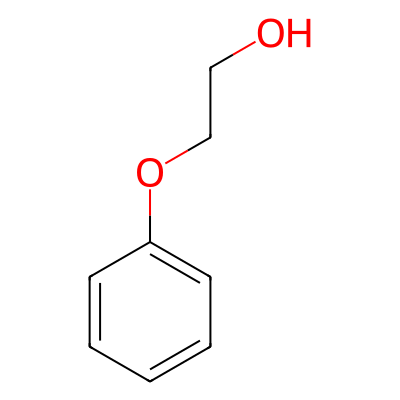
2-Phenoxyethanol
| Associated High Confidence AOPs |
|---|
Associated AOPs with Level of Relevance 1
| AOP Identifier | AOP Title | AO Classification | OECD Status | Coverage Score | KE Identifier | KE Name |
|---|---|---|---|---|---|---|
| AOP:105 | Alpha2u-microglobulin cytotoxicity leading to renal tubular adenomas and carcinomas (in male rat) | Cancer; Urinary System Disease | - | 0.17 | KE:767 | Increase, Hyperplasia (renal tubular cells) |
| AOP:112 | Increased dopaminergic activity leading to endometrial adenocarcinomas (in Wistar rat) | Reproductive System Disease; Cancer | - | 0.17 | KE:111 | Agonism, Estrogen receptor |
| AOP:116 | Cytotoxicity leading to renal tubular adenomas and carcinomas (in male rat) | Cancer; Urinary System Disease | - | 0.25 | KE:784 | Increase, Hyperplasia (tubular epithelial cells) |
| AOP:121 | Urinary bladder calculi leading to urothelial papillomas and carcinomas (in mouse and rat) | Cancer; Urinary System Disease | - | 0.2 | KE:796 | Increase, Hyperplasia (urothelial) |
| AOP:167 | Early-life estrogen receptor activity leading to endometrial carcinoma in the mouse. | Reproductive System Disease; Cancer | - | 0.14 | KE:1065 | Activation, estrogen receptor alpha |
| AOP:335 | AOP for urothelial carcinogenesis due to chemical cytotoxicity by mitochondrial impairment | Cancer; Urinary System Disease | - | 0.2 | KE:796 | Increase, Hyperplasia (urothelial) |
| AOP:443 | DNA damage and mutations leading to Metastatic Breast Cancer | Thoracic Disease; Cancer | Under Development | 0.1 | KE:112 | Antagonism, Estrogen receptor |
| AOP:465 | Alcohol dehydrogenase leading to reproductive dysfunction | Unclassified | - | 0.12 | KE:748 | Increased, Estrogen receptor (ER) activity |
Associated AOPs with Level of Relevance 2
| AOP Identifier | AOP Title | AO Classification | OECD Status | Coverage Score | KE Identifier | KE Name |
|---|---|---|---|---|---|---|
| AOP:504 | SULT1E1 inhibition leading to uterine adenocarcinoma via increased estrogen availability at target organ level | Unclassified | - | 0.33 | KE:1065 | Activation, estrogen receptor alpha |
| AOP:561 | Aromatase induction leading to estrogen receptor alpha activation via increased estradiol | Unclassified | - | 0.2 | KE:1065 | Activation, estrogen receptor alpha |
Associated AOPs with Level of Relevance 3
| AOP Identifier | AOP Title | AO Classification | OECD Status | Coverage Score | KE Identifier | KE Name |
|---|---|---|---|---|---|---|
| AOP:23 | Androgen receptor agonism leading to reproductive dysfunction (in repeat-spawning fish) | Unclassified | WPHA/WNT Endorsed | 0.1 | KE:25 | Agonism, Androgen receptor |
| AOP:30 | Estrogen receptor antagonism leading to reproductive dysfunction | Unclassified | Under Review | 0.17 | KE:112 | Antagonism, Estrogen receptor |
| AOP:117 | Androgen receptor activation leading to hepatocellular adenomas and carcinomas (in mouse and rat) | Cancer; Gastrointestinal System Disease | Under Development | 0.25 | KE:25 | Agonism, Androgen receptor |
| AOP:376 | Androgen receptor agonism leading to male-biased sex ratio | Unclassified | WPHA/WNT Endorsed | 0.25 | KE:25 | Agonism, Androgen receptor |
| AOP:440 | Hypothalamus estrogen receptors activity suppression leading to ovarian cancer via ovarian epithelial cell hyperplasia | Benign Neoplasm; Endocrine System Disease; Reproductive System Disease; Reproductive System Disease; Cancer; Endocrine System Disease | Under Development | 0.11 | KE:1046 | Suppression, Estrogen receptor (ER) activity |
| AOP:445 | Estrogen Receptor Alpha Agonism leads to Impaired Reproduction | Reproductive System Disease | - | 0.12 | KE:1065 | Activation, estrogen receptor alpha |
| AOP:495 | Androgen receptor activation leading to prostate cancer | Reproductive System Disease; Cancer | - | 0.11 | KE:25 | Agonism, Androgen receptor |
| AOP:496 | Androgen receptor agonism leading to reproduction dysfunction (in zebrafish) | Unclassified | - | 0.1 | KE:25 | Agonism, Androgen receptor |
| AOP:503 | Activation of uterine estrogen receptor-alfa leading to endometrial adenocarcinoma, via epigenetic modulation | Reproductive System Disease; Cancer | Under Review | 0.17 | KE:1065 | Activation, estrogen receptor alpha |
| AOP:536 | Estrogen receptor agonism leading to reduced survival and population growth due to renal failure | Unclassified | - | 0.17 | KE:111 | Agonism, Estrogen receptor |
| AOP:537 | Estrogen receptor agonism leads to reduced fecundity via increased vitellogenin in the liver | Unclassified | - | 0.2 | KE:111 | Agonism, Estrogen receptor |
No associated AOPs with Level of Relevance 5
DISCLAIMER
TICToK is a database of tattoo ink chemicals compiled from different regulatory resources. The authors are not liable for any inaccuracies or omissions of any chemicals in this resource. Importantly, our sole goal to build this resource on tattoo ink chemicals is to enable future basic research on this topic, and it does not necessarily reflect the views or objectives of our employers or funders.